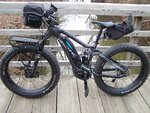I am getting very close to buying something I know almost nothing about. I am thinking of buying a Juiced Bike RipCurrent S or an M2S All Terain 750.
I have never ridden a fatbike before
I have only ridden an ebike once before
I have ridden a normal quite a bit
I plan mostly “rails to trails” which is paved, crushed gravel and dirt. I would also like a little on-road and off road capability. I live in Pittsburgh PA area which is quite hilly and frequently wet. We have a few ebike store around but finding a bike that also has a throttle (which I really want) if hard to find.
Questions:
Thanks for any feedback
I have never ridden a fatbike before
I have only ridden an ebike once before
I have ridden a normal quite a bit
I plan mostly “rails to trails” which is paved, crushed gravel and dirt. I would also like a little on-road and off road capability. I live in Pittsburgh PA area which is quite hilly and frequently wet. We have a few ebike store around but finding a bike that also has a throttle (which I really want) if hard to find.
Questions:
- How much difference does 52v make vs 48v? I see the marketing but would like to know real world experience.
- How well will these things do on long hills (1/2 mile or longer at 15%)? Would rarely do this but I don’t want to get stuck at the bottom.
- How hard are these to transport (car rack)? (thinking about one for my wife also)
- What kind of restrictions might I encounter on trails if I travel out of state?
- I am about 5’11” but would like to get a medium size so I could add a cushioned seat post which will add about 2 "– will the bike be too small?
Thanks for any feedback
